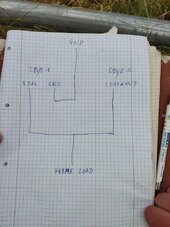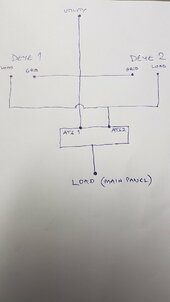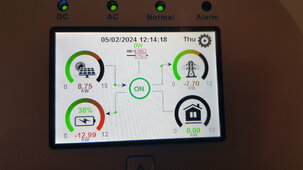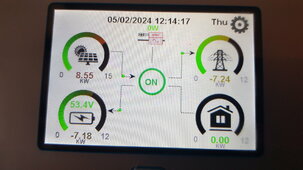Hello everyone,
After a couple of months of lurking on the forum I've finally decided to register and post a thread about my conventional/boring network engineering project that turned into a nightmare when it overlapped with solar technology. For context, I'm a research physicist who does R&D software engineering for a living and dabbles in all things computer related as a side hustle. In other words, I'm a complete amateur when it comes to deploying complex solar technology solutions.
A client hired me to deploy a computer network in his camp which containes a villa, 6 smaller houses, 3 larger ones, 4 outdoor pools, 10 jacuzzis etc. Everything was powered from the public power supply grid and a Deye 50kW hybrid triple-phase inverter coupled to batteries and PV panels. This year, the client decided that he will deploy another inverter, batteries and PV panels 250-300 meters away from the original. The fun began when they told me that I need to establish data comms between them.
I've tried every imaginable network topology and setup to connect them, CAT7 cables (provided by the client) daisy chained over network switches or range extenders, even a PTP wireless setup after I was told that a optical fiber/coax cable solution was unfeasible. No matter what I tried F29 fault kept popping up every single time the installer tried to connect them in parallel.
After painstaking troubleshooting they have let me off the hook - both Deye engineers and company that sold/deployed the second inverter concluded that data comms over that distance are not possible, BUT that it is possible that those two inverters work simultaneously on the same electric network with reduced efficiency. As I've said in the opening, I'm a lightyear away from being an expert in this field, but their statement sounded ludicrous from the get go.
Their suggestion boils down to connecting the inverters through their load ports (rough electrical wiring diagrams are included). I fail to see how are they going to synchronize their phases in that configuration, (non-existent) data comms should do that. I've suggested that they simply separate the inverters and their panels/batteries/loads on respective subcircuits, but the client is extremely frustrated and he is rightfully demanding that the installers deliver what was promised, simultaneous function of 2 inverters on the same electric network.
My question is the following: is his request technically unfeasible and if it's not what are the avenues of approach to tackle this problem. Thanks in advance.
After a couple of months of lurking on the forum I've finally decided to register and post a thread about my conventional/boring network engineering project that turned into a nightmare when it overlapped with solar technology. For context, I'm a research physicist who does R&D software engineering for a living and dabbles in all things computer related as a side hustle. In other words, I'm a complete amateur when it comes to deploying complex solar technology solutions.
A client hired me to deploy a computer network in his camp which containes a villa, 6 smaller houses, 3 larger ones, 4 outdoor pools, 10 jacuzzis etc. Everything was powered from the public power supply grid and a Deye 50kW hybrid triple-phase inverter coupled to batteries and PV panels. This year, the client decided that he will deploy another inverter, batteries and PV panels 250-300 meters away from the original. The fun began when they told me that I need to establish data comms between them.
I've tried every imaginable network topology and setup to connect them, CAT7 cables (provided by the client) daisy chained over network switches or range extenders, even a PTP wireless setup after I was told that a optical fiber/coax cable solution was unfeasible. No matter what I tried F29 fault kept popping up every single time the installer tried to connect them in parallel.
After painstaking troubleshooting they have let me off the hook - both Deye engineers and company that sold/deployed the second inverter concluded that data comms over that distance are not possible, BUT that it is possible that those two inverters work simultaneously on the same electric network with reduced efficiency. As I've said in the opening, I'm a lightyear away from being an expert in this field, but their statement sounded ludicrous from the get go.
Their suggestion boils down to connecting the inverters through their load ports (rough electrical wiring diagrams are included). I fail to see how are they going to synchronize their phases in that configuration, (non-existent) data comms should do that. I've suggested that they simply separate the inverters and their panels/batteries/loads on respective subcircuits, but the client is extremely frustrated and he is rightfully demanding that the installers deliver what was promised, simultaneous function of 2 inverters on the same electric network.
My question is the following: is his request technically unfeasible and if it's not what are the avenues of approach to tackle this problem. Thanks in advance.








